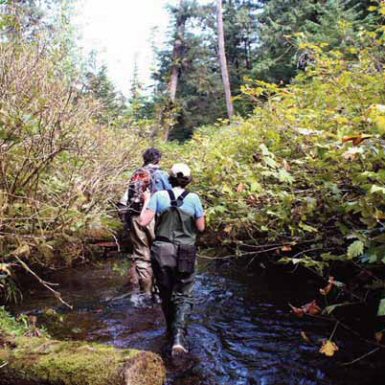SEJournal Online is the digital news magazine of the Society of Environmental Journalists. Learn more about SEJournal Online, including submission, subscription and advertising information.
Feature
By MICHAEL MANSUR
SEJ’s new program helps journalists complete some of their dream reporting, photography projects
 |
|
Jude Isabella accompanied scientists studying salmon streams that have fed indigenous people for thousands of years.
Photo © Jude Isabella.
|
“To be a journalist is to have a passion for truth. To be an environmental journalist is a doubling of that passion,” says Jude Isabella, a freelance journalist.
Isabella, though, also has to pay her bills.
In this changing journalism world, where more dedicated journalists are left worrying more about how they can finance their next reporting project, the Societyof Environmental Journalists has stepped in to help a little with those bills.
It’s all aimed at keeping journalists like Isabella tracking their story.
It’s called the Fund for Environmental Journalism and it currently is accepting applications for its third round of grants. Up to $2,500 will be awarded to environmental reporting projects and other journalism-related entrepreneurial ventures.
SEJ’s board established the program after many members asked for their organization to help fill the void created when so many mainstream journalists became victims of the news industry’s withering, thanks to the recent recession and the dramatic shift in media technology.
Each applicant must meet SEJ’s membership eligibility requirements, but it’s not necessary to actually be a member. It’s your work that SEJ is interested in promoting.
Isabella is among about 30 U.S., Canadian and Mexico-based journalists who already have been helped by the fund. By the way, the fund can also use the help of more journalism-loving donations.
And SEJ soon hopes to help more.
Before we tell you a bit more about Isabella’s project and how SEJ helped her, here’s a rundown of several projects that SEJ’s Fund for Environmental Journalism has already helped:
Ruxandra Guidi, Emeryville, CA, $1,200 for travel for a multimedia project about climate change and forestry in Panama.
Laura Frank and I-News: The Rocky Mountain Investigative News Network, Denver, CO, $1,000 for graphics, photos and videos for an investigative multimedia water project in Colorado.
Eric Mack, Vadito, NM, $1,000 for website development and cost/benefit analysis on energy projects in New Mexico.
Dan Collison and Long Haul Productions, Three Oaks, MI, $750 for travel for an audio documentary on invasive fish in Arkansas, Missouri and Illinois.
Heather Dewar, Baltimore, MD, $725 for travel for adding a BP spill chapter in finalizing book on Florida ocean issues.
Bruce Ritchie and Florida Environments, Tallahassee, FL, $500 for website development.
Kate Golden and the Wisconsin Center for Investigative Journalism, Madison, WI, $500 for water testing for a multimedia project on water and agriculture in Wisconsin.
Lisa Morehouse, San Francisco, CA, $425 for environmental elements of a radio series on changing rural economies in California.
Robert Berwyn and www.summitvoice.org, Frisco, CO, $400 for travel for a multimedia online project on climate change and water pollution in Colorado and Utah.
Jim Carrier, Madison, WI, $400 for travel for a multimedia project on hunters and environmental health in Wisconsin, Colorado and Wyoming.
Some new ventures funded in a second round of grants include Florida Center for Investigative Reporting, which is producing a multimedia project about an environmental issue in Florida.
“Investigative journalism is needed more than ever and SEJ understands the value of supporting watchdog journalism at a time when newsroom resources are dwindling and new models of journalism are emerging on the Internet, providing more opportunities to publish stories that matter,” said McNelly Torres, associate director of the Florida Center for Investigative Reporting. “We are thrilled and thankful that we were selected as recipient of this grant.”
Roberto “Bear” Guerra, who won $1,900 from FEJ in 2010 to help with costs of reporting in Peru’s Amazon Basin on the impacts of the soon-to-be-completed Transoceanic Highway, said that “at a time when fewer and fewer outlets can afford to pay the costs associated with reporting — or in my case, photographing — environmental stories, we run the risk of not knowing about many situations until it’s too late ...
“Today, journalists and photographers simply can no longer do this work without the help of funding from organizations like the Society of Environmental Journalists,” Guerra said. “I hope to see the Fund grow in the coming years, and continue to provide opportunities for journalists to tell the stories that might otherwise not get told.”
Ah, yes, Jude Isabella.
Her $900 FEJ grant allowed her to travel to a remote area of British Columbia to report and photograph with a team of biologists. The trip will be used for a magazine piece, as well as a book on salmons and humans and, maybe, paintings.
“Because my book is about human and salmon life histories, going to this area with biologists was an amazing opportunity,” Isabella said. “It’s also the place where archaeologists have found some of the oldest evidence of Pacific salmon exploitation by humans on the West Coast.
“The scientists took me through the bush, walking along salmon streams that fed people for thousands of years.”
Applications for an FEJ grant can be found here on SEJ's website. Please also consider making a donation to the fund, so even more quality journalists can keep tracking their dream stories.
Michael Mansur, SEJournal editor, reports for The KansasCity Star. He can be reached at mansur.michael@gmail.com
* From the quarterly newsletter SEJournal, Spring 2011 issue.












 Advertisement
Advertisement 



